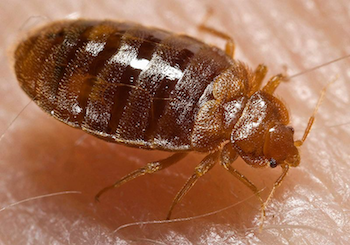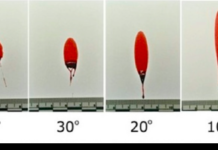R
The familiar idiom “Sleep tight, don’t let the bed bugs bite” is resonating in the minds of people all over the country. Bed bugs are biting again, and in beds close to you.

The world’s largest pest control corporation, Terminix, reported in a May, 2011, press release an increase in bed bug cases across the U.S. So, too, the National Pest Management Association, which tallied a 70% increase in companies treating bed bug infestations since 2001. And the New York City Department of Housing Preservation and Development recorded an increase in bed bug complaints and violations from 15,069 in 2009 to 17,576 in 2010.
In St. Louis, Jay Everitt, staff entomologist at Pest Control, says that his company treated between 75–100 cases of bed bug infestations in 2010. Everitt predicts even more cases this year. His company has already treated nearly 100 cases so far this year, and summer is just beginning.
“Large bedbug infestations have been attributed to increased worldwide travel, altered insecticide management, and increased resistance to pesticides," wrote Christopher Lowe and Marc Romney, medical microbiologists at the Universities of Toronto and Ontario, respectively, in the June. 2011, issue of Emerging Infectious Diseases.
The Centers for Disease Control and Prevention (CDC) describe bed bugs (Cimex lectularius) as small, parasitic insects that live in cracks and crevices of homes, apartments, stores, or other dwellings. Entomologist Richard Houseman, an Associate Professor at the University of Missouri-Columbia, is more blunt, describing bed bugs as “blood-sucking cockroaches” and “hitchhikers” that cannot fly but rely on us to move them around.
Bed bugs can make homes under the edges of carpets, on the ends of curtains, in wall outlets, or any other dark, cool location, warns the CDC. These nocturnal parasites are attracted to CO2 gas, which is exhaled by humans and other animals. Bed bugs use CO2 to locate their victims during the night. Once the victim is found, the bed bugs attach to them, then suck their blood, says the CDC.
A fact sheet on bedbug.org.au, an online directory published by the Institute of Clinical Pathology and Medical Research in Sydney, Australia, explains that the feeding process begins with the bed bug injecting anesthetizing saliva to numb the area where they will suck, along with an anticoagulant to prevent the blood from clotting as they feed. The itching that’s associated with bed bug bites is usually due to the host’s allergic reaction to the saliva. Doctors prescribe an antihistamine and anti-itch cream for discomfort, reports the CDC.
Fortunately, bed bugs do not transmit diseases like ticks. According to the CDC, bed bug bites are more of an annoyance. Itching can cause the victim to lose sleep and even lead to secondary skin infections from excessive scratching.
Bed bugs can inhabit any type of dwelling, although they are mostly found in multi-unit apartment buildings, dorms and hotels, according to Purdue University’s Medical Entomology Department. Modern construction methods have facilitated the spread of bed bugs, since the bugs are able to travel from room to room via air ventilation ducts.
Everitt says that bed bugs die at 122 °F, a temperature high enough to kill the eggs, juveniles (nymph) and adults. When treating an infestation, the heat treatment is thermostatically controlled and maintained at 130–140 °F for at least two hours.
The typical treatment for bed bug infestations includes a combination of heat and chemicals, which Everitt labels a “double barreled approach.” Chemicals, like pyrethrenes and chlorosenapyr, which disrupt the central nervous system, and Delta Dust, which nicks the exoskeleton of the bed bugs, says Everitt. Proper treatment for bed bug infestation can range between $500–1000.
Many companies also employ bed bug sniffing canines to help snuff out these pesky critters. Bed bugs give off a distinct odor, which the dogs are trained to recognize. Dogs are used before treatment to confirm the presence of live bed bugs and after treatment to confirm their absence. Bed bug sniffing canines are able to locate the bugs to 98% accuracy, according to a study by Margie Pfiester and other researchers from the University of Florida’s Department of Entomology that was published in the August 2008 Journal of Economic Entomology.
As many people consider traveling this summer, there are certain precautions that can be taken to avoid picking up these blood-sucking hitchhikers. Houseman encourages travelers to use a flashlight to inspect the edges of mattresses and baseboards in hotels. He also suggests that travelers give their clothes a heat treatment by placing them in the dryer for at least 20 minutes after they return from vacation.
The American Society for Healthcare Environmental Services has several other suggestions for protecting your home against Bed bug infestations:
- Check your mattresses. Bed bugs like to hide out in the cool mattress and wait until night time to emerge for feeding.
- Purchase encasements for mattresses and boxsprings. Encasing prevents the bugs from moving into or out of the mattress or boxspring.
- Inspect incoming furniture. When you purchase furniture from other locations, especially used furniture, be sure to give it a thorough looking over.
- De-clutter your homes. Bed bugs look for any cool spot to rest during the day as they prepare to attack their hosts at night.
Thorough inspection and proper treatment by a pest control agency help ensure that we have a good night, sleep tight, and not let the bed bugs bite.

This work is licensed under a Creative Commons Attribution-NonCommercial-NoDerivs 3.0 Unported License














Wow. I never knew that bed bugs were real. I just thought it was a cute saying for kids. Thank you for writing this article. I learned a lot from it. :good
I was very interested in this article. I even wanted to research some of this myself. I was extremely curious as to how the bite would look. I imagined it would relate to that of a mosquito bite but I was completely wrong! It is so much worse. I posted a link to a picture I found.